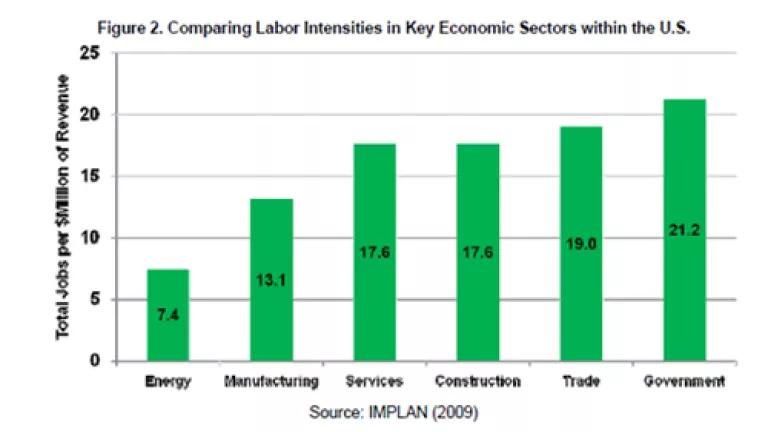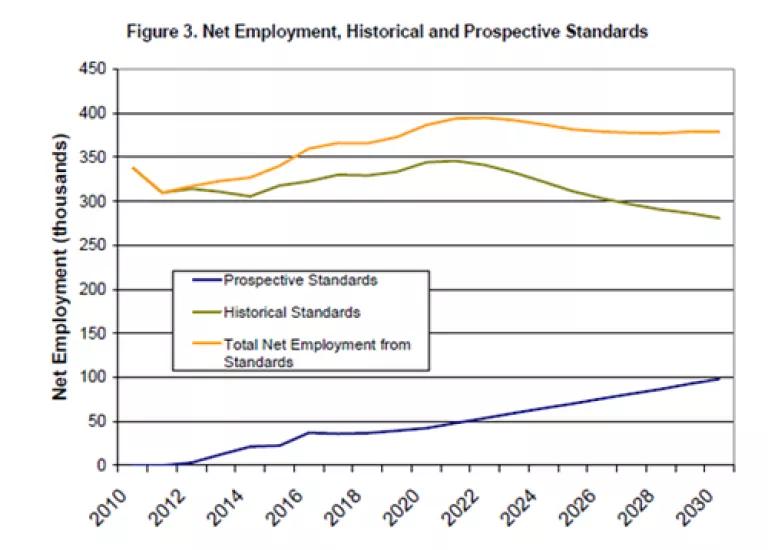
Last week, the American Council for an Energy Efficient Economy and the Appliance Standards Awareness Project published a great report on the jobs created by national appliance energy efficiency standards. The report found that 340,000 jobs have been created to date by standards, which is equivalent to about 0.2 percent of the US economy. The report also found that by 2030 this number would grow to between 380,000 and 490,000 due to the implementation of standards in the pipeline through 2013.
These are important numbers because the study was based on careful analysis of the consequences of the standards throughout the economy. So many of the figures thrown around concerning jobs reflect the job gains in one particular company while ignoring the jobs lost at its competitors, or the gains in one industry that come at the expense of lost jobs elsewhere in the American economy. 380,000 net jobs gained throughout the economy is a significant number: it is roughly equal to the net jobs gained in the last three months throughout the entire US economy.
The key finding of the report is clear: efficiency standards create jobs and help the economy grow. Standards also save consumers money on their energy bills and reduce air pollution that is harmful to human health and the environment.
National energy efficiency standards currently cover over 50 products, ranging from common household appliances like refrigerators and washing machines, to commercial equipment like furnaces and boilers. The first national appliance standards were signed into law by President Reagan in 1987 as part of the National Appliance Energy Conservation Act (NAECA), and have since continued to receive bipartisan support with 5 major pieces of updating legislation. Since energy efficiency is the low hanging fruit that grows back, DOE updates these standards over time as they become outdated. Plans in the pipeline through 2013 include a range of additional standards on which DOE is currently working and a set that have already achieved a broad consensus between advocates and industry, which this Congress is expected to implement.
While standards can have direct job impacts in terms of the manufacturing of specific appliance or equipment, their main job creation effect is from the money consumers don’t have to spend on their utility bills and can spend on other things instead. The report finds that the total net present value of consumer savings from appliance standards through 2030 is almost half a trillion dollars. These are savings that can be spent on other goods and services – going out to eat, toys, clothing, a kitchen remodel, you name it. Generally, this other spending occurs in sectors of the economy which have more jobs per dollar of revenue than the energy sector. As seen from the chart below, the energy sector supports 7.4 jobs per million dollars of revenue, while other key sectors of the economy support 13 to 21 jobs per million dollars. That means that every million dollars not spent on energy bills and spent elsewhere is creating about 5 to 13 additional jobs in other parts of the economy.
Source: ACEEE/ASAP Report, Page 9
There are several good reasons to expect that the number of jobs created by standards will be at the high end of the estimated range in the ASAP/ACEEE report. For example, the low end estimate assumes that some of these savings decay over time at a rate of 5 percent. This is shown in the chart below in the green line representing historical standards (those put in place before 2010), the benefits of which decrease over time. The basis for this assumption is the theory that some of the efficiency would have happened any way in the absence of standards. However, there is no empirical evidence to support this theory and there is anecdotal evidence that in the absence of standards many products do not increase in efficiency or even experience declines in efficiency. This was the case for water heaters and refrigerators during the 30 plus years between WWII and the enactment of the first standards. This has also been the case for televisions and associated electronic equipment, as well as mobile phones. In some cases, standards drive efficiency even before they are put in place by providing manufacturers certainty – this is the case for the high efficiency incandescent bulbs which are available now even though the standards don’t take effect nationally until next year. These bulbs likely would not have come to the market if the standard had not been put in place. The decay rate assumption ends up having a large effect on the job creation numbers. A zero percent decay rate would lead to 490,000 jobs created in 2030 (compared to 380,000 using the 5% as shown in the chart below).

Source: ACEEE/ASAP Report, Page 10
While the decay rate is the biggest factor, there are several other assumptions in the report that suggest the actual jobs will be at the higher end of the projections. These include:
- Cost of standards: The low end job estimate assumes that costs are as estimated by the Department of Energy in their technical analysis. However historically, DOE has overstated the cost of new technology by anywhere from 20 to 310% (in the limited number of cases reviewed). In the sensitivity analysis, the report found that with 20% lower costs, prospective standards would create 99,000 jobs in 2030 compared to 98,000 using DOE’s cost data.
- Water savings: Several of the appliance standards have significant water savings impacts (for instance, my colleague Ed Osann has blogged about the water savings from consensus standards on clothes washers and dishwashers). These have the same economic impact as energy cost savings in that consumers have more money in other parts of the economy, but are not accounted for in the analysis. This would also lead to even larger job creation numbers.
- Finally, the report doesn’t take into account the effect of decreased demand on energy prices. Appliance standards decrease energy demand which decreases energy prices (another ASAP/ACEEE report found that existing standards have decreased US electricity demand by 7 percent in 2010). This puts even more money back in consumer’s pockets, which leads to further job creation.
